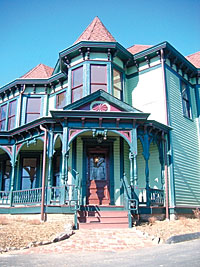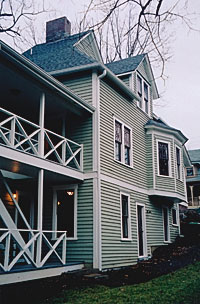
photos courtesy of Preservation Society of Asheville and Buncombe County
Queen of Haywood: The Queen Anne-style Whiteford G. Smith House is one of only two remaining Victorian homes on Haywood Street.
A new lease on life: After a major restoration effort, this home at 28 Soco St. won an award for best residential rehabilitation in Montford. New electrical, plumbing and a laundry chute topped off this restoration.
|
I doubt I’m the only history dilettante in town whose heart sank at the sight of industrial Dumpsters outside the Whiteford G. Smith House on Haywood Street in downtown Asheville. In fact, I went so far as to enact a drive-by shooting (of the digital-camera variety) to save — at least in pixels — the rundown Queen Anne.
Luckily, the Dumpsters weren’t omens of a teardown but the first phase in restoring the home’s former royal presence. Of course, in Asheville there’s a propensity for rescuing seemingly unsalvageable buildings from the clutches of time, neglect and kudzu. There’s also an equally strong (if not quite so dramatic) movement to preserve historic gems for posterity.
“That one had been sitting there sort of moldering for years,” observes Harry Weiss, urban-projects director for Public Interest Projects, a local development company. Nearly all of the Montford Historic District, which begins just a block away from the Haywood Street renovation, has already been restored, so an overhaul of the Smith House was long overdue.
And if seeing such local architectural gems brought back from death’s door weren’t reward enough, the Preservation Society of Asheville and Buncombe County hands out annual awards for notable feats of architectural conservation. This year’s Griffin Awards ceremony, held May 19 in the Grove Arcade, honored projects ranging from a refurbished former retail store that’s now a restaurant to a former no-tell motel reborn as classy condominiums. The event also featured a talk by Weiss on the past 15 years of local restoration efforts.
Transforming downtown’s abandoned places into livable spaces is a continuing trend. “The lion’s share of reconstruction in Asheville has been upper-floor residential,” notes Weiss. “The idea is to get it into use,” he says of such structures as the Sawyer Motor Company Building. “One of the key strategies for preservation is to read the building [and] adapt to what the building has to offer.” And this year’s Griffin Award winners testify to the wide range of uses that creative minds have found for Asheville’s historic infrastructure.
• Residential Rehabilitation: 31 Highland St. Owners: Peter Brezny and Trina Egen. Most likely built between 1912 and 1915 as a duplex, this two-story pebbledash home served as a rental for some 30 years before the couple purchased it. They completed the restoration work themselves, creating a modern, energy-efficient house with a ’20s feel.
• Adaptive Reuse: Whiteford G. Smith House, 263 Haywood St. Owner: G/M Property Group LLC. Contractor: Bobby Stearns. Woodwork and reproduction: Craig Weis. Built in 1894, this is one of only two remaining Queen Anne-style homes on Haywood Street. Preserved features of the house, which is listed on the National Register of Historic Places, include turned and bracketed porch columns, period mantels and five-panel doors with original hardware.
• Commercial Rehabilitation: 375 Weaverville Highway. Contractor: Matt Moss of Moss Construction Group. Local legend has it that Col. Harland Sanders (of KFC fame) owned this 1930s motor court. The original 15- or 16-unit property has been converted into efficiency apartments, with renovations focused on returning the exterior as closely as possible to its original look. Items such as Eastlake hardware and art deco hinges were salvaged.
• Interior Commercial Rehabilitation: 12 Church St. Owners: John Yurko and David Aiton. Architects: John Yurko and David Aiton. Originally used as the architectural offices of Richard Sharp Smith, this building is now home to the Minerva gallery and, appropriately, two architectural firms. Renovations included restorating the heart-pine floors and lime-plaster walls.
• Adaptive Reuse: 37 Hiawassee St. Owners: Urban Space of Asheville. Architect Robbie Sweetser of Griffin Architects. Contractor: Abbott Construction. In its previous life, this property, which was completed in 1963, was the Interstate Motel, boasting 55 rooms and a $29 nightly rate. It was transformed into 32 residential condos with full amenities and an egress barrier to minimize traffic noise.
• Residential Rehabilitation: 73 Edgemont Road. Owners: Geoff and Cheryl Smith. Contractor: Woodworth Inc. This 1960s ranch house had a makeover, emerging as a 1920s-style Arts and Crafts bungalow. Salvaged and vintage supplies include a clawfoot tub and stained-glass windows.
• Addition to a Historic Residence: Violet Cottage, 48 Sunset Terrace. Owners: Deborah and Gordon Pirie. Architect: Robbie Sweetser of Griffin Architects. Contractor: A&B Construction and Development. Grove Arcade architect Charles N. Parker designed this 1920s Arts and Crafts chalet. Improvements included replacing a poorly constructed one-story bay with a new two-story bay.
• Residential Rehabilitation, Montford: 28 Soco St. Owners: Joseph and Wanda Newman. Restoration craftsman: Tim Petree. This early 1900s Queen Anne-style home underwent major restoration. From structural repair to refinishing the heart-pine floors, the house was returned to its original glory — with a few modernizations like new electrical and plumbing systems and the addition of a laundry chute.
• Rehabilitation: Mt. Zion Missionary Baptist Church, 47 Eagle St. Steward: Dr. John Grant. Contractor: Stroup Sheet Metal Works. Built in 1919 in the African-American commercial district, this church received stone masonry repairs as well as a new roof. New tin shingles with a galvanized-steel finish were made from original patterns.
• Commercial Restoration: Jackson Building, 22 S. Pack Square. Steward: Landmark Properties. Known as Asheville’s first skyscraper, this 13-story building was constructed in 1924. The Gothic exterior, sheathed in brick and terra cotta, was reconditioned to extend the building’s life.
• Interior Commercial Rehabilitation: The Lobster Trap, 35 Patton Ave. Owner: Amy Bell. Architect: Cynthia Turner of Glazer Architecture. Contractor: Rick Flemming of RPF Construction. This building started out as the J.H. Law China and Cutlery Store in 1885 and has housed a series of retail shops. For its latest incarnation as a restaurant, sprinklers and a full kitchen and bar were added.
• Adaptive Reuse: West Condominium, 51 College St. and 35 Patton Ave. Owners: Steve and Mary Ann West. Architect: Laurie Miller of Glazer Architecture. Contractor: Rick Flemming of RPF Construction. Occupying the same building as the Lobster Trap, this condo received structural repairs and upgrades. The boarded ceiling was salvaged, hardwood floors were added, and an existing chimney was utilized for a gas-log fireplace.
• New Construction, Montford: Schultz Cottage, 40 Watauga St. Owner: Shirley Schultz. Architect: Laurie Miller of Glazer Architecture. Contractor: Greg Borden. When Schultz decided to move to Asheville, she chose a perfect location: a cottage behind her daughter’s Richard Sharp Smith-designed home. In order to make the new construction fit into the Montford Historic District, cues were taken from the main home, including a dropped gable roof and pebbledash stucco.
• New Construction, Downtown: Sawyer Annex, 120 Coxe Ave. Owner: Sawyer Annex LLC. Architect: Fisher Architects. Contractor: Rick Flemming of RPF Construction. After renovating the 1926 Sawyer Motor Company Building (formerly a car dealership) into condos and retail/office space, the owners performed the same magic on the three-story annex.
• Individual Award for Leadership: John Horton, a restoration specialist with the North Carolina Department of Cultural Resources’ Office of Archives and History. Horton has served in the Biltmore Village-based historic-preservation office for 15 years, surviving many budget cuts and bureaucratic challenges. His duties include coordinating grant-in-aid and tax-credit programs as well as monitoring the rehabilitation of National Register properties.
For more information on the Griffin Awards and historic preservation, call the Preservation Society of Asheville and Buncombe County at 254-2343 or visit their Web site (www.psabc.org).




While researching china made for J.H.Law I ran across your Mountian Xpress News on the web. Can you tell me more about the J.H.Law China and Cutlery Store started, I believe, in 1885. Has this store become the Whiteford G Smith House on Haywood Street? My wife owns a couple blue and white plates imprented with The Rowland & Marsellus Co. Staffordshire England [designed & imported by J.H.Law, Ashville]. Her grandparents from Ohio often visited the area and purchased the plates. No one is around in the family with which to speak about the store. I guess my curiosity has come with age!